How was the Iowa Farm Crisis of the 1980s a crisis for more than rural farmers?
Background of Farm Crisis
In the early 1970s, Iowa farm families experienced economic prosperity.The farm economy boomed as farm production grew, exports expanded, and land values increased. The state’s total population was over two million with 42 percent of Iowans living on farms or in small towns. By 1990, the state lost population overall, with the decline in rural Iowa being the most substantial. One in four farms was no longer in operation in 1989. As farmers expected the prosperity of the 1970s to continue, a combination of economic, political and technological factors led to the greatest crisis in rural communities since the Great Depression of the 1930s. Many farmers expanded their acreage through land purchases or purchased new equipment with loans. However, when the Federal Reserve raised their lending, in an effort to stabilize inflation, it increased the cost of borrowing money for everyone in the United States. The effect on farmers, their families and others in rural America was devastating.
International Factors
International factors contributed to a decline in farm income. In 1979 the Soviet Union invaded Afghanistan and in protest President Jimmy Carter penalized the USSR by suspending U.S. grain shipments. Other nations filled this need and the Soviets suffered little. Though President Ronald Reagan removed the embargo when he took office in 1981 the farm economy had been damaged as exports declined. In addition, the embargo caused a glut of corn in the U.S. leading to a drop in prices from over $3.15 a bushel in 1979 to under $2.15 in 1982, and under $1.55 in 1987.The U.S. dollar also gained in value with a 26 percent increase from 1980 to 1984. This increase made U.S. goods including crops more expensive on the international market. Debt and a decline in income led to extreme emotional and financial stress as farms failed.
Farmer's Relief
Farmers across the nation protested and sought relief from their state governments and the federal government. Farmers participated in national “tractorcades” to Washington, D.C. organized by the American Agriculture Movement in 1979 and 1980. Iowa groups active in the 1980s were the PrairieFire Rural Action Network led by Rev. David Ostendorf, Iowa Farm Unity Coalition led by Dixon Terry, and the Iowa Farm Bureau Federation led by Bob Joslin and Merlin Plagge. PrairieFire organized “white cross” protests at auctions and courthouses beginning in 1984 in Wayne County to object to farm foreclosures. The group held rallies across the state through the mid-1980s including events in Audubon, Story, and Tama Counties. Hilton Coliseum in Ames was the site of the National Crisis Action Rally on February 27, 1985. Musician Willie Nelson and others founded Farm Aid in 1985. The organization held the first Farm Aid concert in Champaign, Illinois on September 22, 1985. Fifty-four acts performed before a crowd of more than 75,000 people and raised more than seven million for farm families. Iowa never instituted a farm foreclosure moratorium as was done in the Great Depression. Political leaders and advisors sought to reform the loan and credit system. Rural banks started closing and millions of dollars were lost by people in town and on the farm. The Farm Credit System was reformed and bailed out by the federal government in 1985. A 1987 New York Times article reported in, “Iowa, state health figures show that about 47 farmers have killed themselves each year since 1980.” Food pantries sprang up in rural communities to offer hunger relief. Government cheese giveaways provided important protein, as did livestock donation programs. Iowa State University Extension offered counseling by telephone on its “Rural Concern Hotline.” From October 1, 1984 to December 31, 1985, the hotline communicated with 11,900 people. The university also held meetings and support groups across that state that interacted with more than 50,000 Iowans. In 1986, Congress introduced Chapter 12 Bankruptcy which allowed family farmers to restructure their finances and avoid liquidation or foreclosure. In 1987, the Agriculture Credit Act authorized a four billion financial assistance package for financially vulnerable institutions of the Farm Credit System. Prices rebounded, debt was slowly reduced, and the 1980s Farm Crisis abated.
Supporting Questions
What factors led to the Iowa Farm Crisis of the 1980’s?
- Causes of the Farm Crisis, 2013 (Video)
- The Farm Debt Crisis of the 1980S: a Review Essay, 1992 (Document)
- PUBLIC LAW 96-72—SEPT. 29, 1979, 1979 (Document)
- S.2200 - A bill to impose a trade embargo against the Union of Soviet Socialist Republics until its troops and their support units withdraw from Afghanistan., 1980 (Document)
How was Iowa’s entire economy and population impacted by the farm crisis?
- A Special and Terrible Irony: Hunger on Iowa's Farms during the Agricultural Crisis of the 1980s, 2019 (Document)
- Remarks at the Annual Convention of the National Corn Growers Association in Des Moines, Iowa, 1982 (Document)
- Farm Crisis Impact on Rural Communities, 2013 (Video)
- Farm Crisis Results in Suicide and Murder, 2013 (Video)
How did Iowans persevere during the 1980s Farm Crisis?
- Using History to Make History? Progressive Farm Organizing During the Farm Revolt of the 1980S, 1996 (Document)
- Picket Lines, Picket Fences: How Feminism Saved Iowa’s Family Farms During the Farm Crisis of the 1980s, 2014 (Document)
- Rural Advocacy Groups During the Farm Crisis, 2013 (Video)
- Remarks and a Question-and-Answer Session With Farmers in Norway, Iowa, 1984 (Document)
Farm Crisis of the 1980s Teaching Guide
Farm Crisis of the 1980s Image and Document Guide
Farm Crisis of the 1980s Supplemental Inquiry Resource
Causes of the Farm Crisis, 2013
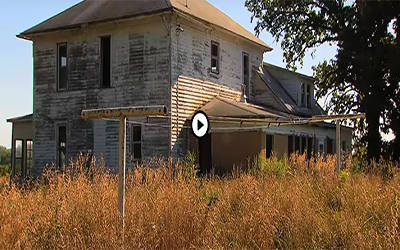
Description
A video excerpt from a 2013 Iowa PBS production entitled “The Farm Crisis”. This particular section outlines the causes for the 1980s Farm Crisis in Iowa and across the Midwest. The video included narration, interviews with key individuals who experienced the Farm…
The Farm Debt Crisis of the 1980s: a Review Essay, 1992
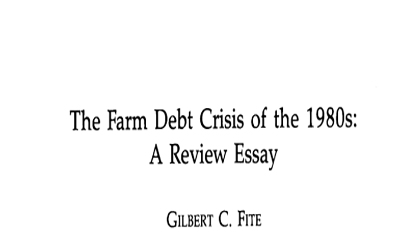
Description
A review of three books written by Gilbert Fite. Through his review, Fite highlighted the different factors related to the 1980s Iowa Farm Crisis which were addressed in each book.
PUBLIC LAW 96-72—SEPT. 29, 1979
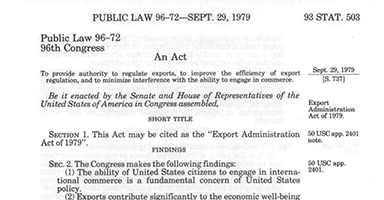
Description
The Export Administration Act of 1979 provided the President of the United States the authority to control United States exports for reasons of national security, foreign policy and short supply. This Act existed from 1979 to 1994; however, it could be…
S.2200 - A bill to impose a trade embargo against the Union of Soviet Socialist Republics until its troops and their support units withdraw from Afghanistan., 1980
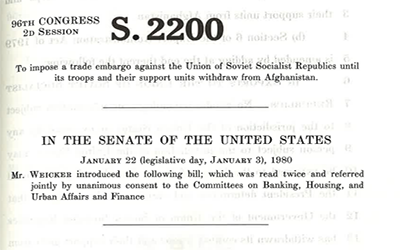
Description
Senate Bill 2200 was introduced and sponsored by Senator Lowell Weicker in 1980. It included a measure to place a trade embargo on the Soviet Union in response to that country sending troops into Afghanistan. The bill would also amend the 1979 Export…
A Special and Terrible Irony: Hunger on Iowa's Farms during the Agricultural Crisis of the 1980s, 2019
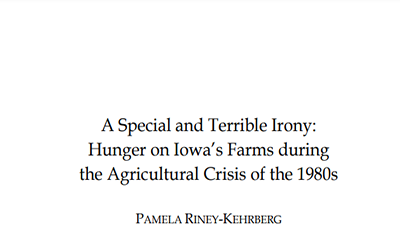
Description
An article written by Pamela Riney-Kehrberg from Iowa State University that talks about the struggles of the Iowa farmer during the 1980’s Farm Crisis. Discussed in the article are some of the factors that led to the Farm Crisis, the impact on Iowa farmers and the…
Remarks at the Annual Convention of the National Corn Growers Association in Des Moines, Iowa, 1982

Description
President Ronald Reagan’s remarks at the Annual Convention of the National Corn Growers Association in Des Moines, Iowa, in 1982. He spoke on the state of our nation as well as on the Farm Crisis taking place, and what was being done to try to recover.
Farm Crisis Impact on Rural Communities, 2013

Description
A video excerpt from a 2013 Iowa PBS production entitled “The Farm Crisis”. The video discusses the impact on not just the Midwestern farm, but also across the entire Iowa economy including banks, farm implement dealers and manufacturers, and small…
Farm Crisis Results in Suicide and Murder, 2013

Description
A video excerpt from a 2013 Iowa PBS production entitled “The Farm Crisis”. This selection is entitled “Farm Crisis Results in Suicide and Murder” and discusses the mental and emotional toll on Iowan farmers and their families.
Using History to Make History? Progressive Farm Organizing During the Farm Revolt of the 1980s, 1996
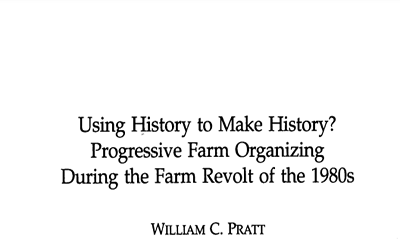
Description
An article written by William Pratt about the Farm Revolt of the 1980s. Pratt notes that during Farm Crisis, many farmers united to create several grassroots organizations to protest against the government actions that caused Iowan farmers and communities to…
Picket Lines, Picket Fences: How Feminism Saved Iowa’s Family Farms During the Farm Crisis of the 1980s, 2014

Description
An article written by William Pratt about the Farm Revolt of the 1980s. During the Farm Crisis, many farmers united to create several grassroots organizations to protest against the government actions that caused Iowan farmers and communities to suffer. The author…
Rural Advocacy Groups During the Farm Crisis, 2013
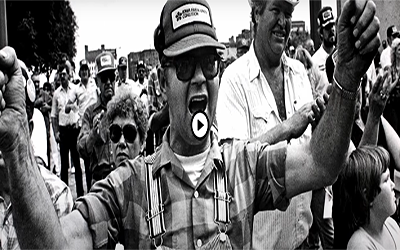
Description
“Rural Advocacy Groups During the Farm Crisis” is a video excerpt from a 2013 Iowa PBS production entitled “The Farm Crisis”. This selection discusses the ways people advocated for governmental and societal support for Iowa and Midwestern farmers during…
Remarks and a Question-and-Answer Session with Farmers in Norway, Iowa 1984
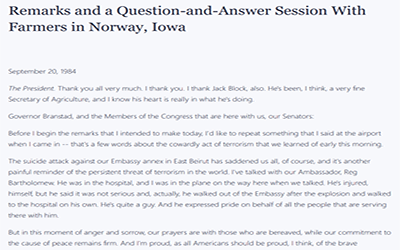
Description
President Reagan and Secretary of Agriculture Jack Block spoke at a rural Iowa farm outside of Norway, Iowa, in September 1984. In a question-and-answer session, the President and Secretary answered questions and outlined the government’s efforts to help farmers…
Additional Resources
- Iowa PBS: The Farm Crisis
“The Farm Crisis is a 90-minute film produced by Iowa PBS that examines the economic and personal disasters that afflicted the agriculture sector in the 1980s” - Banking and the Banking and the Agricultural Problems Agricultural Problems of the 1980s
Chapter 8 of a study prepared by the FDIC's Division of Research and Statistics. Produced in 1997, it provided an analysis of the several factors that led to bank failures during the 1980s. - IOWA PRODS REAGAN ON FARM AID
Article from the Chicago Tribune about then Governor Branstad, Senator Tom Harkin and Charles Grassley and other state governmental officials calling on President Reagan to provide farm aid to failing farms - 15,000 Farmers Angrily Protest Reagan Policies
Article from the Los Angeles Times about a National Farm Rally in Ames, Iowa, in support of farmers and agricultural struggles in the Midwest during the Farm Crisis - Forever Changed: The Effects Of '80s Farm Crisis Linger
Iowa Public Radio broadcast from 2019 from the Talk Of Iowa program about the 1980s Iowa Farm Crisis exploring how it changed farming and our state forever. - What is ANF?
Website from Iowa Farm Bureau that discusses University of Iowa and then Head Coach Hayden Fry’s “America Needs Farmers” logo and slogan that was used to show support to Iowa’s farmers during the Iowa Farm Crisis of the 1980’s and how it continues today. - Iowa History 101: When a Dream Dies: Agriculture, Iowa and the Farm Crisis of the 1980s
This presentation, led by Pamela Riney-Kehrberg, focused on the 1980s Farm Crisis impact on the families and communities of Iowa as well as how a decade of stress challenged everyone involved in the business of agriculture.
Iowa Core Social Studies Standards
Listed below are the Iowa Core Social Studies content anchor standards that are best reflected in this source set. The content standards applied to this set are middle school-age level and encompass the key disciplines that make up social studies for sixth-grade students.
| No. | Standard Description |
| SS.7.16 | Examine the origins, purposes, and impact of laws, treaties, and international agreements. (21st century skills) |
| SS.7.19 | Explain how external benefits, costs, supply and demand, and competition influence market prices, wages, and outcomes. |
| SS.7.20 | Investigate the impact of trade policies and barriers on a nation and its citizens. |
| SS-Gov.9-12.28. | Identify local and state issues in Iowa and evaluate formal or informal courses of action used to affect policy. |
| SS-Econ.9-12.13. | Apply the concept of scarcity when making economic decisions |
| SS-Econ.9-12.17. | Explain how changes in supply and demand cause changes of goods and services, labor, credit, and foreign currencies |
| SS-Geo.9-12.20. | Assess the impact of economic activities and political decisions on urban, suburban, and rural regions. Analyze Global Interconnections |
| SS-Geo.9-12.21. | Analyze how changes in the environmental and cultural characteristics of a place or region influence spatial patterns of trade and land use. |